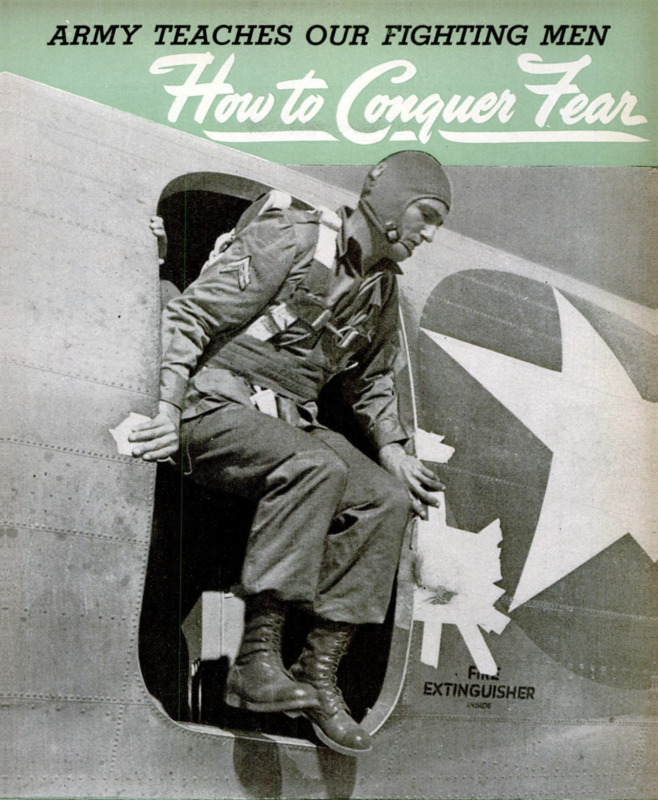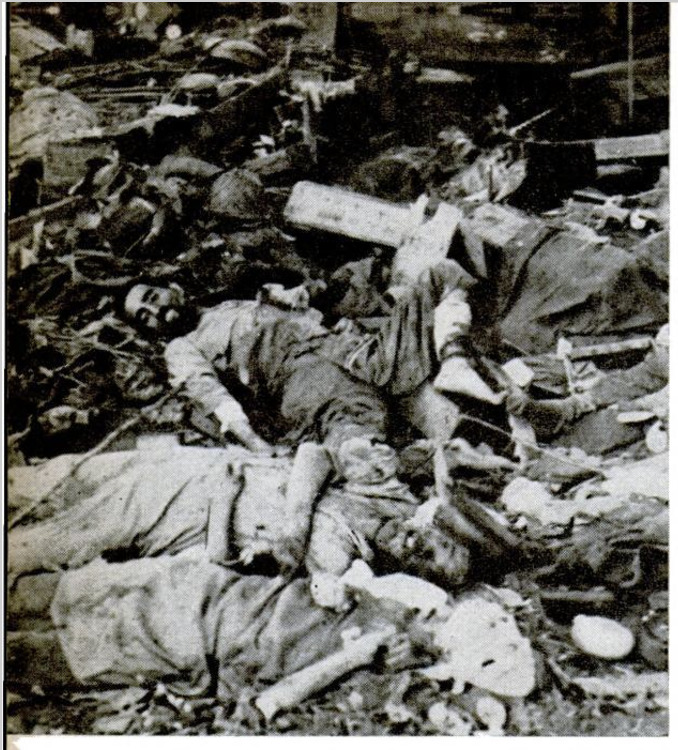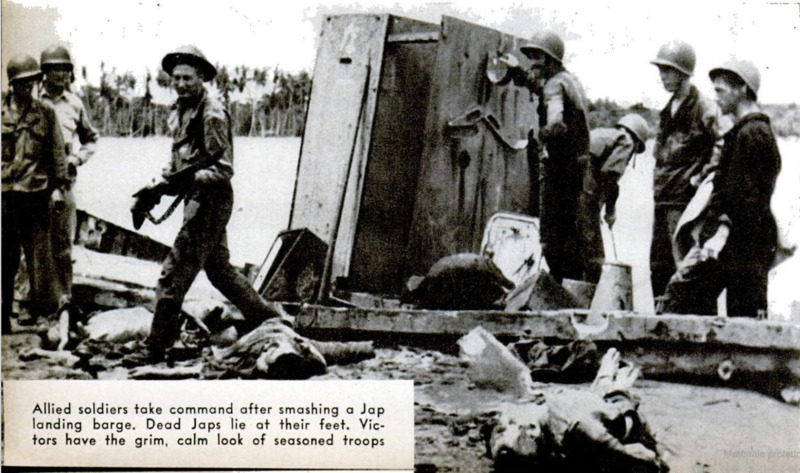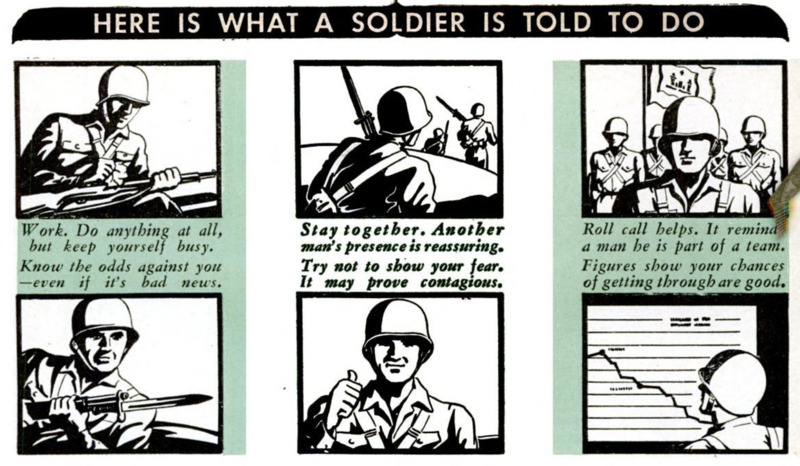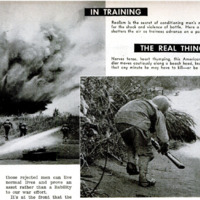-
Title (Dublin Core)
-
Army Teaches Our Fighting Men How to Conquer Fear
-
Article Title and/or Image Caption (Dublin Core)
-
Army Teaches Our Fighting Men How to Conquer Fear
-
extracted text (Extract Text)
-
WAR is a frightening occupation for
our soldiers. On every front they
must be prepared not only to take what the
enemy has in the way of terror, but to dish
it out in bigger and stronger doses. It's a
fearsome job for young men whose nearest
approach to violence once was to shout,
“Kill the umpire!”
But great camouflaged transports are
carrying these young men in increasing
numbers to the war zones. Many already
have passed months in battle sectors where
all the furies of modern warfare rage.
Blasting, strafing dive-bombers have howled
out of a foreign sun to slice the air over
their foxholes. Unholy screams of wings
and motors and bombs have torn at their
eardrums. Shattered rocks and flying stone
have added to the threat of shrapnel. They
have known lack of food and water, the
tenseness of the zero hour, the sight of
friends and comrades being killed and
wounded before their eyes.
These former bookkeepers, clerks, farm-
ers, and factory hands are being exposed
to all the horrors of war. It makes little
difference what outfit they're with—in-
fantry, tanks, tank-busters, air forces, para-
troops, engineers—they feel the fury of it.
Some have cracked under the terrific strain.
Authentic reports show that nearly one
third of the first casualties shipped back
were mental and nervous cases. But the
fight goes on, with veterans, replacements,
and fresh troops carrying the battle to the
enemy.
Army officers are confident that our men
have the stuff needed for victory. Some of
that confidence stems from the belief that
our soldiers have the finest and most mod-
ern equipment in the world; some comes
from the knowledge that they are excel-
lently trained, know how to use their weap-
ons; some springs from proof of their great
physical stamina, and some comes from the
historical fact that American soldiers have
yet to lose a war. But a factor not to be
overlooked is the Army's remarkable new
program to combat fear and mental in-
stability. For this is responsible to a large
degree for our success in turning millions
of civilians into first-class fighting men.
From induction centers to training camps
to battle areas, our soldiers are feeling the
effects of the program. It's helping them to
withstand the pressure of Army life on
minds, nerves, and emotions. It's assisting
them to be competent, dependable, coura-
geous; and it's untangling minds that have
become twisted by the stresses of war. This
is the first time that such an effort has been
made on a large scale.
Employed only in rudimentary form late
in World War I, the process was started
last year with the creation of a neuro-
psychiatric branch in the Surgeon General's
Office in Washington. Then followed the
opening of a unique school in Lawsen Gen-
eral Hospital, Atlanta, Ga., in which in 196
hours of classes young Medical Corps offi-
cers are being fitted for the special service.
Selected with great care by Col. Roy D.
Halloran, chief of the wranch, and ranking
Medical Corps psychiatrists, they are as-
signed after graduation to one of the nine
Army commands in this country. Later,
when they are sent abroad, they work under
the direction of the mew neuropsychiatric
centers established in the European and
South Pacific theaters.
Personnel and morale officers, chaplains,
and field officers assist the psychiatrists in
the program. Never before has there been
such co-ordination of effort to improve sol-
diering and make it more palatable. The
psychiatrists not only watch and help in-
dividual soldiers, but they seek to create
conditions wherein the stresses are mini-
mized. They help devise means of relaxation
and entertainment. They live with the
troops, experience their difficulties, and help
to solve them. Colonel Halloran says of
them: “They are specially trained medical
confidants, with a real desire and ability to
help.”
But even more than that, these new
friends of our soldiers stand as a safeguard
against one of the worst tragedies of battle
—the thousands of war-induced mental
cases that usually occur. For from the
gateway to the Army, where an average of
seven out of every 100 men up for induc-
tion are screened out as mentally unstable,
to the point of embarkation, those Who
show tendencies to crack are sent back to
their homes. In peaceful surroundings,
those rejected men can live
normal lives and prove an
asset rather than a liability
to our war effort.
It's at the front that the
supreme test for the Army's
program comes. That's the scene for the
all-out fight against fear. By that time the
soldier has learned many things about the
science of war and wants to use that
knowledge to blast the enemy. But his
eagerness is mixed with dread and fright.
The first time he goes into battle, he's apt
to be downright scared. His throat becomes
dry; his stomach feels like flipping, and his
heart does a dance macabre under his khaki
tunic. And that may be true every time he
gets within striking distance of the enemy
But he must learn to control his fear.
Experience has shown that fewer sol-
diers go to pieces in outfits with good mo-
rale, in winning outfits, and in well-trained
outfits. It's the psychiatrists’ job to main-
tain confidence. They know that men under
fire or about to go under fire want facts,
not psychiatric patter. So their tactic is
to discuss fear frankly, stressing the fact
that to be scared is a normal reaction
shared by veterans and green troops alike—
not a sign of cowardice.
Fear, as demoralizing and uncomfortable
as it may be, actually is the body's prepara-
tion for action. The heart beats faster,
pumping blood to the arms, legs, and brain
where oxygen is needed. Quickened breath-
ing is the part cf the lungs. Blood pressure
goes up, and adrenalin, nature's “shot in
the arm,” pours liberally into the blood
stream. Sugar is released as fuel for the
human fighting machine.
That's the normal reaction during the
frightening moments just before an attack.
Sometimes the soldier feels stunned and
paralyzed, and has difficulty getting started
into battle. But the Army's program of
training and discipline comes to his aid,
and it becomes second nature to obey com-
mands and carry out his own job. That's
why there is so much importance attached
to keeping fear under cantrol—conquering it.
The Army has six ways to fight fear. For
men facing that greatest period of tense-
ness—just before the zero hour—the slogan
is: “Work—do anything—but keep busy.”
Action relieves stress on minds and nerves.
Troops under fire should keep in contact
with comrades, if that is at all possible.
Just the presence of another r:an mot far
off helps quiet fear.
Calling the roll is helpful. It reminds the
men that they are part of a close-knit or-
ganization, not facing the dangers alone.
Great reassurance comes with knowledge
that every man is in his place, despite the
smoke and din of battle, and resistance to
fright mounts.
Another important remedy against fear,
strange as it seems, is to keep soldiers in-
formed of the odds confronting them. Offi-
cers are urged to keep in mind that knowl-
edge is power over fear. Men posted on the
dangers, the kind of weapons they're up
against, and the size of the enemy's force
are far less susceptible to fear.
Soldiers are taught that to be afraid
doesn’t mean they must act afraid. Since
fear is contagious when it is expressed by
action, men who become panicky must be
removed from the sight of other men. It
is the soldier's responsibility to control
signs of his own fear if he can, so as to
spare his comrades. Fighting men have
learned that the very effort often reduces
fear and brings calmness.
Soldiers are acquainted with statistics
on the percentage of casualties in action.
That is reassuring. For, according to fig-
ures on even the bitterest fights, compara-
tively few men are killed, and the chances
that any one man will be among the fatally
wounded in any one battle are relatively
small.
The Army knows that courage and fear
are not opposites—that they may be pos-
sessed by a soldier at the same time. But
the soldier who has courage need not worry
about his feeling of fright. He'll keep that
under control. In the words of the National
Research Council: “None but the brave can
afford fear.”
In talks that I have had with some of
our wounded soldiers brought back from the
war zones for treatment in the Army's great
Walter Reed Hospital, in Washington, it
was interesting to note how few admitted
having experienced fear. One chap, who has
been decorated with the Silver Star for dis-
tinguished service in North Africa, summed
it up by saying: “Hell, we were too busy to
get scared.” His ritation said that, although
painfully wounded, he had pushed forward,
causing enemy gunners to fire upon him and
reveal their position, bringing about their
defeat.
This 22-year-old veteran said, however,
that he and his comrades experienced a few
“uneasy moments” ns they were waiting
orders to start the invasion. He said they
showed it In funny ways. For instance, one
soldier cleaned and recleaned his rifle. An-
other looked at his watch every few seconds,
and a third couldn't seem to satisfy himself
that his gun was loaded, checking it a dozen
or so times.
Our young hero and his comrades may
have been scared stiff, but they had learned
that secret trademark of a good soldier—
fear control. The magnificent thing I ran
onto was the universal eagerness of the
wounded to get back in the fight. They
seemed to resent the fact that the boys with
whom they went overseas were stil in the
thick of things, while they were forced to
“loaf in & hospital.” The Army's program
has sold them on the idea that Army life,
despite its hazards, is not so frightening.
That “salesmanship” is significant. For
the success of neuropsychiatry is measured
by the number of soldiers kept in the Army
not by the number eliminated. Is axio-
matic that many of war's greatest exploits
are achieved by veterans who have returned
to the fight after their wounds have healed.
Other valuable contributions have been
chalked up by men whose first maladjust-
ments might have wrecked their Army
careers had they not been corrected. Take
the case of fellows who develop Jitters while
on training maneuvers. These same soldiers
have been transformed into first-rate cooks,
‘mechanics, and bullders who have a vital
part to play in winning the war.
Those who are being shipped back from
North Africa and the South Pacific as
mental and nervous cases benefit greatly
from the program. The neuropsychiatrists
Who treat them are experienced in straight-
ening minds. They know that these casual-
ties are not insane—that with proper treat.
ment they will respond in a locale that has
Done of the dangers and fury of the fighting
fronts. The trouble in most cases is that
these men came from obscure little grooves
in civil life, and their minds slipped when
they came ‘up against the rigors of war.
Most of them will be able to return to the
lite they lett.
As in the case of men awaiting the zero
hour, the psychiatrists recommend that the
‘meurotics be kept busy. So at Walter Reed
and the other great Army hospitals you find
them deeply engrossed in occupational ther-
apy. Some make belts, ship models, chess.
men; others knit or embroider. A few
skilled in the arts are kept occupied with
paintbrush and clay. With their hands busy,
their minds have less chance of groping and
strength of thought and direction seeps
back.
Looking ahead to the period immediately
after the war, the neuropsychiatrists appear
slated for work equally as important as that
In which they are now engaged. For they
alone know the things about the returning
soldiers that will make it possible to fit them
back into civilian life. As they now are
helping soldiers out of unhappy situations
into niches that make soldiering endurable,
they will be able to guide the veterans to
happier ground. Having come from civilian
lice themselves, the psychiatrists will them-
Selves return to it, and there continue to give
advice and aid to the men whom they helped
to lick fear and the enemy.
-
Contributor (Dublin Core)
-
Jack O'Brine (writer)
-
Signal corps photo (photos)
-
Language (Dublin Core)
-
eng
-
Date Issued (Dublin Core)
-
1943-08
-
pages (Bibliographic Ontology)
-
49-53
-
Rights (Dublin Core)
-
Public Domain (Google digitized)
-
Archived by (Dublin Core)
-
Matteo Ridolfi
-
Alberto Bordignon (Supervisor)
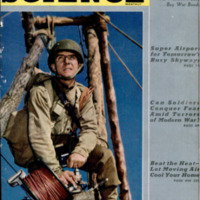 Popular Science Monthly, v. 143, n. 2, 1943
Popular Science Monthly, v. 143, n. 2, 1943

